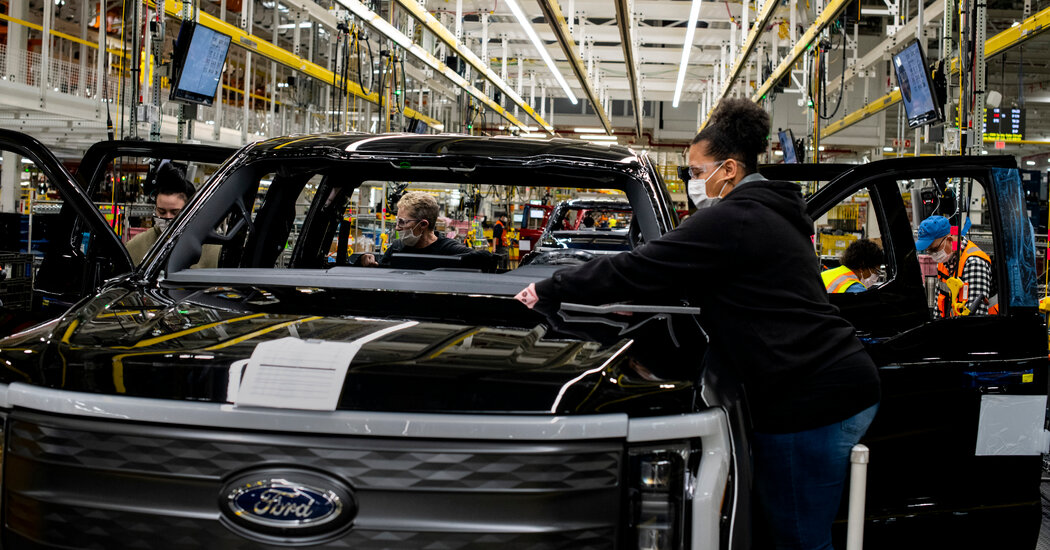
Sales of cars powered solely by batteries surged in the United States, Europe and China last year, while deliveries of fossil fuel vehicles were stagnant. Demand for electric cars is so strong that manufacturers are requiring buyers to put down deposits months in advance. And some models are effectively sold out for the next two years.
Battery-powered cars are having a breakthrough moment and will enter the mainstream this year as automakers begin selling electric versions of one of Americans’ favorite vehicle type: pickup trucks. Their arrival represents the biggest upheaval in the auto industry since Henry Ford introduced the Model T in 1908 and could have far-reaching consequences for factory workers, businesses and the environment. Tailpipe emissions are among the largest contributors to climate change.
While electric vehicles still account for a small slice of the market — nearly 9 percent of the new cars sold last year worldwide were electric, up from 2.5 percent in 2019, according to the International Energy Agency — their rapid growth could make 2022 the year when the march of battery-powered cars became unstoppable, erasing any doubt that the internal combustion engine is lurching toward obsolescence.
The proliferation of electric cars will improve air quality and help slow global warming. The air in Southern California is already a bit cleaner thanks to the popularity of electric vehicles there. And the boom is a rare piece of good news for President Biden, who has struggled to advance his climate agenda in Congress.
The auto industry is on track to invest half a trillion dollars in the next five years to make the transition to electric vehicles, Wedbush Securities, an investment firm, estimates. That money will be spent to refit and build factories, train workers, write software, upgrade dealerships and more. Companies are planning more than a dozen new electric car and battery factories just in the United States.
“It’s one of the biggest industrial transformations probably in the history of capitalism,” Scott Keogh, chief executive of Volkswagen Group of America, said in an interview. “The investments are massive, and the mission is massive.”
But not everyone will benefit. Makers of mufflers, fuel injection systems and other parts could go out of business, leaving many workers jobless. Nearly three million Americans make, sell and service cars and auto parts, and industry experts say producing electric cars will require fewer workers because the cars have fewer components.
Over time, battery ingredients like lithium, nickel and cobalt could become more sought after than oil. Prices for these materials are already skyrocketing, which could limit sales in the short term by driving up the cost of electric cars.
The transition could also be limited by the lack of places to plug in electric cars, which has made the vehicles less appealing to people who drive long distances or apartment residents who can’t charge at home. There are fewer than 50,000 public charging stations in the United States. The infrastructure bill that Congress passed in November includes $7.5 billion for 500,000 new chargers, although experts say even that number is too small.
And it could take time to see the climate benefits of electric cars: Replacing the 250 million existing fossil-fuel cars and light trucks could take decades unless governments provide larger incentives to car buyers. Cleaning up heavy trucks, one of the biggest sources of greenhouse gas emissions, could be even harder.
Still, the electric car boom is already reshaping the auto industry.
The biggest beneficiary — and the biggest threat to the established order — is Tesla. Led by Elon Musk, the company delivered nearly a million cars in 2021, a 90 percent increase from 2020.
Tesla is still small compared with auto giants, but it commands the segment with the fastest growth. Wall Street values the company at about $1 trillion, more than 10 times as much as General Motors. That means Tesla, which is building factories in Texas and Germany, can easily expand.
“At the rate it’s growing now, it will be bigger than G.M. in five years,” said John Casesa, a former Ford executive who is now a senior managing director at Guggenheim Securities, at a Federal Reserve Bank of Chicago forum in January.
Most analysts figured that electric vehicles wouldn’t take off until they became as inexpensive to buy as gasoline models — a milestone that is still a few years away for moderately priced cars that most people can afford.
But as extreme weather makes the catastrophic effects of climate change more tangible, and word gets around that electric cars are easy to maintain, cheap to refuel and fun to drive, affluent buyers are increasingly going electric.
Porsche’s Taycan, an electric sedan that starts at about $83,000, outsold the company’s signature 911 last year. Mercedes-Benz sold nearly 100,000 electric cars and vans in 2021, a 90 percent increase from the previous year.
Ford will soon start selling the Lightning, an electric version of the F-150 pickup truck, which has topped U.S. sales charts for decades. It initially planned to make 75,000 a year. But demand has been so strong that the company is racing to double production of the Lightning, which starts at $40,000 and runs up to more than $90,000. Ford stopped taking reservations after amassing 200,000.
“We’re going to be able to sell every one we can build,” said Hau Thai-Tang, Ford’s chief product platform and operations officer.
A growing selection of electric pickups and sport utility vehicles is attracting buyers uninterested in Tesla’s minimalist cars, which are most popular in coastal cities and suburbs.
Take Eddie Berry, the owner of an auto-parts delivery business in Groveport, Ohio, near Columbus. He has long relied on pickup trucks for work and camping trips. He had little interest in electric vehicles until the Lightning. His roughly $75,000 truck will be delivered this spring.
“There’s so much about this truck that’s going to help me,” Mr. Berry said. The locking front trunk, where an engine normally sits, will give him a secure space to carry parts. He won’t spend $80 for fuel every few days.
And since the Lightning can be used as a power source, it will revolutionize his tailgate at Ohio State football games. “I’ll be able to set up my big-screen TV,” Mr. Berry said. “I can power the electric smoker I use for ribs and pork. I’m superexcited. I’m going to be the guy everybody’s talking about.”
Sales of electric cars might have been even higher in 2021 but for production bottlenecks. Volkswagen sold about 17,000 ID.4 S.U.V.s in the United States, but could have sold four times as many, Mr. Keogh said.
Mike Sullivan, owner of LAcarGUY, a dealership chain, sold out his ID.4s within weeks of their arrival. “When we have them it’s the best-selling model,” he said. Supply will increase this year when Volkswagen begins producing ID.4s in Chattanooga, Tenn., rather than importing them from Germany.
The Infrastructure Bill at a Glance
At the upper end, electric vehicles are already competitive on price and could save buyers thousands on maintenance and gasoline. (Electric cars do not need oil changes, and electricity is generally cheaper per mile than gasoline.)
The Tesla Model 3 and Jaguar XF P250 sedans retail for around $46,000. But owning the Tesla for five years costs $16,000 less, according to calculations by Kelley Blue Book, a vehicle valuation company.
If Europe and China are any measure, sales of electric vehicles in the United States will continue to explode. In December, battery-powered cars outsold diesel cars in Europe for the first time. In 18 countries, including Britain, more than 20 percent of new cars were electric, according to Matthias Schmidt, an independent analyst in Berlin.
In 2015, more than half of Europe’s new cars ran on diesel, the result of tax policies that make diesel cheaper than gasoline. But government incentives for electric cars, and penalties for carmakers that don’t meet emissions targets, have changed the equation.
About 4 percent of new cars were electric last year in the United States, up from about 2 percent in 2020.
The point of electric cars is to cut tailpipe emissions, a leading source of carbon dioxide and the pollutants that cause of smog. In Southern California, electric cars have already had a small impact on air quality, leading to a 4 percent reduction in nitrogen oxide emissions from passenger cars compared with what they would have been otherwise, according to the South Coast Air Quality Management District, which includes Los Angeles.
Of course, battery-powered cars also have an environmental cost. But even taking into account the energy and raw materials they require, electric vehicles are much better for the climate than conventional cars, according to a Yale School of the Environment study.
Inevitably, a transition this momentous will cause dislocation. Most new battery and electric car factories planned by automakers are in Southern states like Georgia, Kentucky, North Carolina and Tennessee. Their gains could come at the expense of the Midwest, which would lose internal combustion production jobs.
That hasn’t happened yet, because gasoline vehicles still dominate sales. But as battery power takes market share, conventional models will benefit less from the cost savings that come from stamping out the same vehicle hundreds of thousands of times.
The next few years could be perilous for carmakers that have been slow to offer electric vehicles. Toyota, a pioneer in hybrid vehicles, will not offer a car powered solely by batteries until later this year. Ram does not plan to release a competitor to Ford’s Lightning until 2024.
Chinese companies like SAIC, which owns the British MG brand, are using the technological shift to enter Europe and other markets. Young companies like Lucid, Rivian and Nio aim to follow Tesla’s playbook.
Old-line carmakers face a stiff learning curve. G.M. recalled its Bolt electric hatchback last year because of the risk of battery fires.
The companies most endangered may be small machine shops in Michigan or Ontario that produce piston rings and other parts. At the moment, these businesses are busy because of pent-up demand for all vehicles, said Carla Bailo, chief executive of the Center for Automotive Research in Ann Arbor, Mich.
“A lot of them kind of have blinders on and are not looking that far down the road,” Ms. Bailo said “That’s troubling.”




